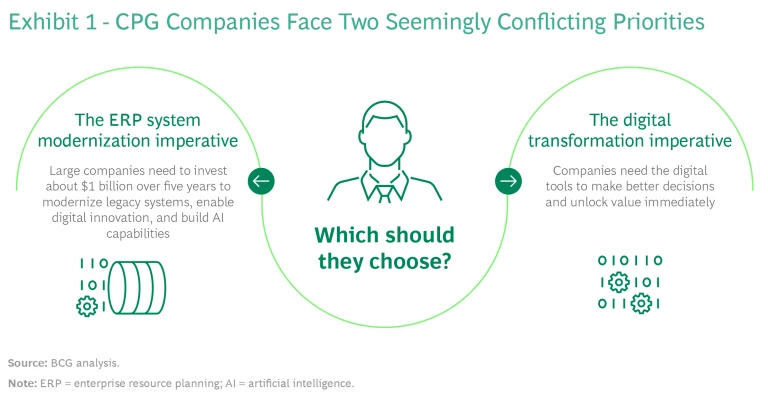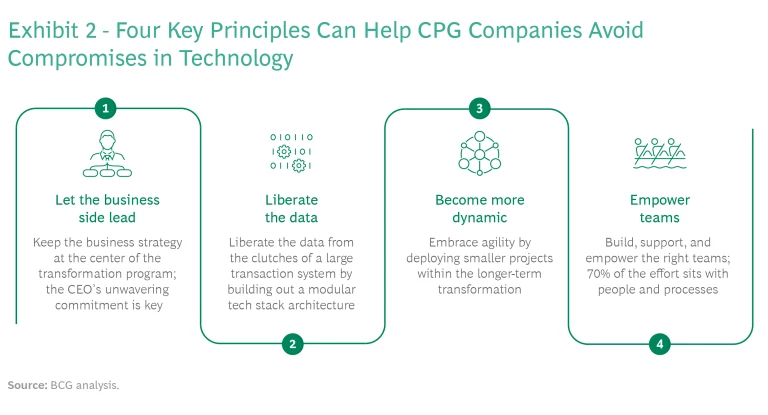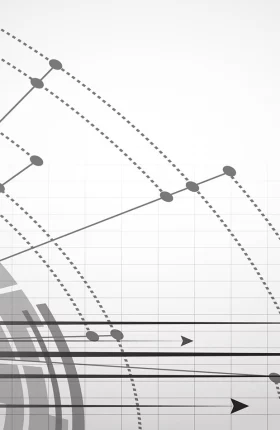CPG firms face a long-term need to update their enterprise software and a short-term need to implement a digital transformation. With the right approach, they can accomplish both.
Most consumer packaged goods (CPG) companies have a dilemma. They need to upgrade their enterprise resource planning (ERP) systems—a multiyear modernization effort that will cost hundreds of millions of dollars. However, a CPG digital transformation—a near-term value-driven initiative that is increasingly urgent in order to remain competitive—is also an imperative. How do they choose which to pursue?
In short, CPG companies should do both—and they can. By correctly sequencing the steps for an ERP system modernization and a digital transformation, companies can create one program that achieves both objectives at the same time.
What’s required? Four principles are crucial. A company must let the business side lead, liberate the data, become more dynamic, and empower its teams. By using this approach, we’ve seen CPG companies achieve the dual objectives in half the time and at half the cost of a traditional ERP implementation and generate twice the impact across the enterprise.
The Dilemma
For CEOs at CPG companies, the reasons to worry are many. Incumbents’ traditional advantages—scale, marketing reach, and relationships with retailers—are far less relevant than in the past. Consumers expect more personalized experiences. Digital native competitors with direct-to-consumer models get up and running, and seize market share, within months. Retailers create and monetize new competitive advantages using their customer and transaction data. And the pandemic and the current economic environment have led to new sources of uncertainty, including supply chain disruptions, shifts in consumer behavior, and higher input costs.
CEOs realize that trying to cling to the status quo will make their company a sitting duck. But it is also difficult to identify the best path forward when faced with two imperatives—modernizing an ERP system and initiating a digital transformation —that seemingly compete with each other. (See Exhibit 1.) Achieving both goals requires transforming at different speeds while increasing the return on investment in technology and analytics.
Modernizing the Core Tech Stack. Most CPG companies have legacy ERP platforms that run complex, mission-critical—and often highly customized—processes. In BCG’s recent CIO survey, 75% of large CPG companies said that they plan to completely modernize their core ERP system in the next three years. Their efforts will include technical upgrades, rationalizing and consolidating current technology, and streamlining business processes, such as those related to manufacturing, supply chain operations, finance, and sales.
The promise of these ERP modernization initiatives is the ability to unlock new digital and analytics capabilities—and those potential advances are the reason companies hesitate to invest in shorter-term digital initiatives that seemingly will deliver the same benefits. Many executive teams think of it like spending money to fix an old car when you’re about to buy a new one. But that doesn’t have to be.
Driving and Scaling Digital Capabilities. CPG companies also need to take immediate steps to improve their digital capabilities and use advanced analytics and artificial intelligence (AI). These steps are important to unlock value across the same business processes in order to personalize customer touch points, for example, as well as more accurately forecast sales, improve pricing and promotion, and reduce manufacturing waste.
To be clear, many companies have made significant investments in AI solutions for CPG processes, but those applications are often siloed within IT organizations or business units, and they often fail to scale or return the business value anticipated. Only about 11% of companies across all industries report significant financial benefits—an alarmingly low percentage. The silver lining is that companies know they need to do better. Nearly 90% of surveyed CPG companies anticipate large-scale AI implementations across customer-facing and operations use cases over the next 18 to 24 months.
Four Key Success Principles
Where does a company start—with the long-term modernization of its ERP system or the short-term digital transformation? We believe that’s a false choice, and the right answer for most CPG companies is one program that does both. Leading companies are pursuing this approach and reducing their total cost, shortening the time to completion, and accelerating the value by using data and analytics.
Several principles are critical in executing a program that modernizes an ERP system and implements a digital transformation concurrently. (See Exhibit 2.)
Let the business side lead. Companies need to keep the business strategy at the center of the program. Business leaders—not just the tech function—need to have complete buy-in at the start and show support throughout, and the efforts should be led by business leaders. The CIO is responsible for executing the program, but the CEO carries the overall responsibility for its success. Furthermore, since the business units will be the primary users and beneficiaries of the effort, their input and buy-in will be critical to realizing the benefits.
Business units need to actively engage with the program team to communicate their needs and prioritize their use cases. Business units’ needs and priorities must cascade down to the lower levels of the organization. Use cases should be broken out by platform, function, and market region, along with their potential value and the implementation time required. Resources will almost certainly need to be reallocated over time on the basis of early pilots and in line with changing business priorities; these adjustments are inevitable and should be anticipated.
Liberate the data. Legacy ERP systems are highly effective at executing complex business processes and transactions. But the data in these systems is often fragmented, inconsistent, and hard to access. To address these issues, companies should seek to liberate the data by making it accessible in near real time. A loosely integrated digital and data platform (DDP) can do exactly that by operating alongside the ERP system and exchanging data with it using application processing interfaces (APIs) and services. Critically, the DDP can operate with both the current ERP and the new ERP once it is in place.
Companies that follow this modular tech structure—in CPG and other industries—generate several advantages:
- Faster time to market, which helps a company quickly identify market needs and get new products into the market to meet those needs
- Reduced complexity of a company’s technology and infrastructure, which makes it better equipped to meet its business needs
- Standardized integration, which enables IT to incorporate new technologies as they become available
- Increased access to data, which gives end users data when they want it and how they want it—and is crucial for unlocking value
Become more dynamic. CEOs are often reluctant to experiment with digital innovation in CPG. In part, that’s because many incumbents have highly established processes and significant institutional inertia. Instead, companies need to become more dynamic and think of digital, data, and AI not as a single comprehensive solution but as a set of use cases within the longer-term transformation—smaller experiments through which the company can build up experience and insights, and then adjust accordingly.
Through this kind of test-learn-scale approach, successful pilots get scaled up across the organization, and the ones that didn’t hit the market are shut down and put through a review process to understand the lessons learned. Teams are encouraged to define measurable outcomes for their pilots before launching and to assess their progress along the way. Setbacks have to be treated as an inherent part of the process. In that light, cutting or downsizing some initiatives should be seen as a sign of healthy portfolio management. This is a different way of thinking, but it can lead to better long-term results. By making a lot of thoughtful, targeted bets, companies can win big.
Cutting or downsizing some initiatives should be seen as a sign of healthy portfolio management.
Companies should apply this same concept to improving organizational data—prioritizing it to support the most immediate use cases, rather than overhauling the entire data system of the organization.
Empower teams. Companies need to resist thinking that success represents a purely technological fix. Change management is a critical ingredient to success, driving leaders to adopt new business processes and engage the organization in each initiative.
Additionally, companies need to invest in retraining existing employees and rethinking ways of working in order to retool the workforce. Hiring new talent, which is needed to support upgraded functions and capabilities, is a must. And changing organization structures, removing layers of oversight and bureaucracy, is required so that teams can operate with greater agility and autonomy. Teams should be given broad mandates and empowered to make their own decisions about how best to achieve their goals.
How Two Companies Put These Ideas into Practice
A leading beauty company is transforming itself in response to a changed market, where purchasing journeys increasingly happen entirely online and the historical advantages of scale have eroded. The objective is to put data and technology at the core of the company’s strategy in order to enable personalized engagement with consumers, superior insights and innovation, and a flexible, responsive supply chain.
Specifically, the company is consolidating its ERP systems while it establishes a common data platform and governance capabilities and creates a new operating model for how IT partners with the business units. To support the transformation, the company has reskilled its technology workforce and brought some critical competencies that were previously outsourced back in-house. The modernized tech stack and data capabilities will enable analytics and AI use cases across the value chain, delivering quantifiable value to the business and insights into new sources of competitive advantage.
In another example, a leading home-care products company was grappling with multiple legacy ERP platforms and the need for frequent manual intervention in its archaic business processes. In response, the company launched an initiative to modernize its core ERP and data platforms to lay the foundation for rapid, technology-led innovation. Recognizing that these efforts will take years and sizeable investments, the company chose to launch select “speedboats”—smaller-scale projects that could move quickly and realize value—while modernizing the core.
One of the speedboats involved supercharging marketing’s personalization effort using consumer data to generate targeted insights and, ultimately, make its marketing more relevant to consumers. The speedboat decreased the time to launch digital marketing pilots from weeks to days. On the basis of early, positive results, the company more than doubled the share of the marketing budget allocated to digital initiatives.
A second speedboat involved building new AI-enabled demand-, sales-, and supply-planning capabilities that will enhance planning accuracy by as much as 20 percentage points once fully deployed. These pilots are using data from the company’s legacy ERP platform and other connected systems, but this approach will enable seamless migration to the modern SAP S/4HANA platform once it is deployed.
CPG companies may feel that they need to choose either a long, expensive modernization of their ERP system or a short-term digital transformation to capitalize on data and analytics, and that either option requires compromises. That’s a false choice. Companies can create one program to execute the two initiatives concurrently—provided that they think about the process in the right way and keep some core principles in mind. By correctly structuring the steps to modernize an ERP system and implement a digital transformation, companies can equip themselves to use digital, data, and analytics more effectively, which will help them listen and react to the market—and win.
















